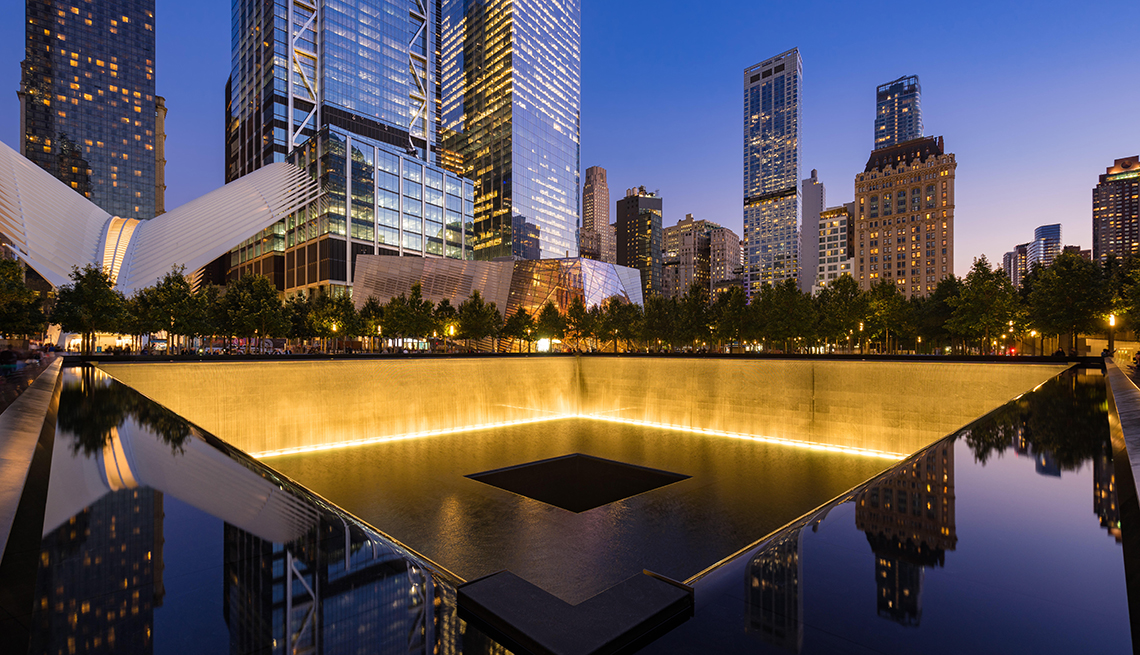AARP Hearing Center
Walk just two minutes from New York's One World Trade Center in Lower Manhattan and a powerful architectural memorial of the catastrophic events that took place here on Sept. 11, 2001 will quickly move you. The National 9/11 Memorial & Museum commemorates that terrible day when terrorists crashed American Airlines Flight 11 and United Airlines Flight 175 into the North and South Towers of the World Trade Center, about 16 minutes apart, killing 129 people aboard the planes, nearly 2,200 office workers, and more than 400 first responders.
The memorial
The simplicity of the memorial, which opened on Sept. 11, 2011, prompts visitors to contemplate the voids left by the buildings’ destruction. The name of the winning design, by architect Michael Arad and landscape architect Peter Walker, was “Reflecting Absence.”
If you go
Location: 180 Greenwich St. in New York
Hours: The memorial is open daily from 10 a.m. to 5 p.m., while the museum is currently open Thursday-Monday, also from 10 a.m. to 5 p.m. On Sept. 10, the last public entry to the museum is at 3:30 p.m. On Sept. 11, the area is closed to the public. (See more on 9/11 events, below.)
Cost: Visiting the memorial is free. Museum admission is $26 for adults, $20 for adults 65 and up. Entry is free for family members of the victims and first responders.
COVID-19 update: Masks are required, and timed tickets must be purchased in advance. Beginning on Sept. 13, New Yorkers and visitors will need to show proof of COVID-19 vaccination to enter restaurants and other indoor public spaces. Keep up on the latest rules at NYCgo.com.
In the middle of a field of more than 400 swamp white oak trees, two one-acre reflecting pools cover the exact footprints where the Twin Towers stood. Thirty-foot waterfalls cascade down the black granite walls that frame the pools, with 52,000 gallons per minute running over their sides. The sound of the water, blocking out the city's noise, is meant to encourage quiet contemplation.
It's particularly moving to see the 2,983 names inscribed in bronze around the edges of the pools, one for each of those killed in the three terrorist-related crashes that day — at the Twin Towers, the Pentagon and in rural Pennsylvania — as well as the six who died when a bomb exploded in the North Tower's parking garage in 1993.
Near the South Pool you'll find the 9/11 Memorial Glade, featuring six monoliths created with metal salvaged from the collapsed World Trade Center. It honors all the first responders, workers and survivors who were exposed to the toxins from the blast.


The museum


AARP's Full 9/11 Anniversary Coverage
Read and view more stories of rescue, recovery, grieving and healing, as we mark two decades since the tragic attacks of Sept. 11, 2001.
Enter the 110,000-square-foot below-ground museum through an above-ground pavilion. Inside, the sobering exhibit “In Memoriam” further drives home the magnitude of the tragedy. Outside, you can read the names of the 2,983 victims. This exhibit gives them faces: From floor to ceiling, four walls are lined with portraits of the victims, aged 2 to 85 and representing 90 nations.


































































